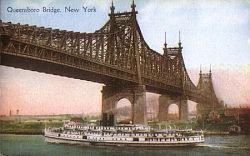 | |||||||
| Home | About Us | Email Us | Find It | What's New | Back | Next | |
| VIEWER MESSAGES | ||
|
| MISCELLANEOUS | ||||
|
||||
 Click on image to enlarge
A vintage picture postcard showing the Queensboro Bridge shortly after its opening.
|
Queens Boulevard Rapid Transit
Source:
- Al Linsky lived in Kew Gardens from 1938 to 1963 and attended P.S. 99 from 1944 to 1953. He is now retired, splitting his time between Brentwood, CA and Woodmere, NY. His avocation is as a broker of antique vehicles to the motion picture and television industry.
The first genuine rapid transit to ply Queens Boulevard probably began sometime after the Queensborough Bridge was inaugurated in 1909, and has been a franchise of one company or another ever since.
Electric trolley cars opened the era shuttling passengers back and forth from Jamaica Avenue in Queens to 2nd Avenue and 59th Street in Manhattan over a pair of tracks on the center median of the boulevard (a panoramic view of Queens Boulevard and Union Turnpike, circa 1930's, elsewhere on this site shows in great detail not only the rails but also the overhead wiring that powered the equipment).
The trolley industry was in a state of flux in its infancy with companies buying and selling each other in frenzied fashion, and names changing almost as quickly as movie marquees! According to a 1925 map of Kew Gardens, the New York & Queens Electric Railway was the operator of record and probably remained so until around 1933.
An M & Q Bus.
[Photograph courtesy of Al Linsky.]
The Manhattan and Queens Bus Corporation (a subsidiary of Green Bus Lines) began regular service on the route, which was designated as # Q60. The name M. & Q. was dropped in 1947 and all buses ran under the Green Line flag thereafter.
The other, which was the construction of the Independent Eighth Avenue subway, would change the habits of central Queens commuters forever. As the first attempt by the City of New York at underground railway construction in Queens, the line ran from 169th. Street and Hillside Avenue to Queens Boulevard, along Queens Boulevard (with an unusual station in Kew Gardens), and across Roosevelt Avenue continuing under the East River to Manhattan servicing both Sixth and Eighth Avenues.
Unlike the tunneling methods used in Manhattan to negotiate a mostly bedrock terrain, Queens Boulevard's sandy foundation lent itself to a faster and easier "cut and cover" installation (in cut and cover construction, a trench is dug, subway structure is built and then covered with concrete). As I mentioned, the Kew Gardens Union Turnpike station was unusual. Actually, it was a marvel of modern engineering!
[From the David Pirmann Collection courtesy of nycsubway.org]
A plan to continue the subway to the city line in Bellerose in the late forties only extended it as far as 179th. Street.